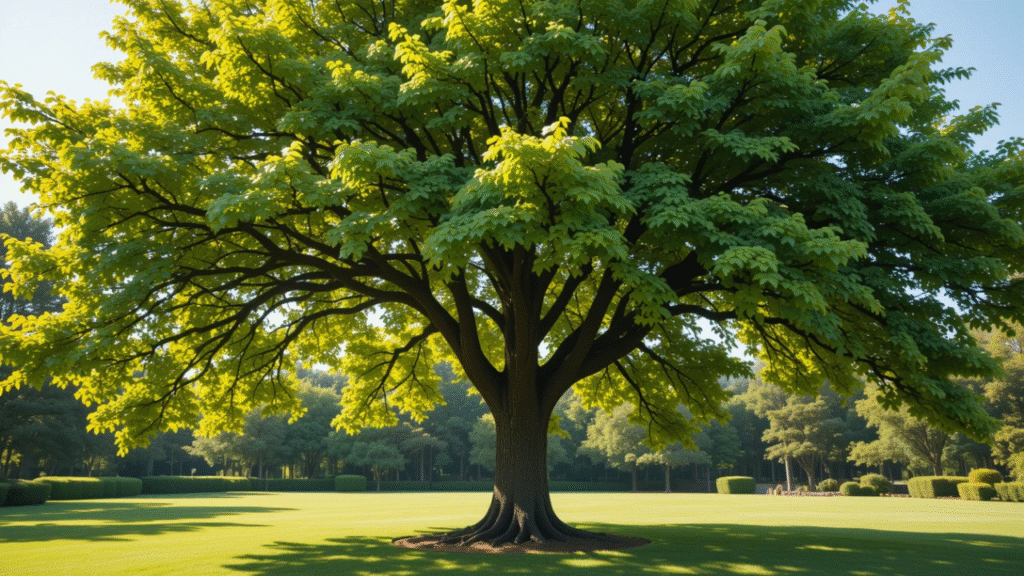
Everything You Need to Know About the Shamel Ash Tree: Benefits, Care Tips, and Landscaping Ideas
Are you looking for a tree that combines beauty, low maintenance, and environmental benefits? 🌳 The Shamel Ash tree might be exactly what you need! Whether you’re a gardening novice or a seasoned landscaper, this fast-growing, versatile tree offers a wealth of advantages that can transform your outdoor space. From its elegant foliage to its ability to thrive in urban settings, the Shamel Ash tree is a top choice for homeowners and landscapers alike.
In this article, we’ll walk you through everything you need to know about the Shamel Ash tree: how to care for it, the unique benefits it brings to your garden, and how to incorporate it into your landscaping plans. Whether you’re planting one for shade, aesthetic appeal, or environmental reasons, we’ve got you covered with practical, actionable tips that will help your tree thrive. Keep reading to discover how this tree can become the centerpiece of your landscape and the key to creating a greener, more vibrant outdoor space. 🌿
Table of Contents
Toggle🌳 What Is the Shamel Ash Tree? 🌳
The Shamel Ash tree (Fraxinus uhdei) is a fast-growing, hardy tree that’s perfect for a wide range of landscapes. 🌍 Native to Central America and Mexico, it thrives in warm climates 🌞 and can be a standout addition to any garden or urban environment. 🌳 But what makes this tree truly special? Let’s break it down! 😊

🌱 Key Characteristics of the Shamel Ash Tree 🌱
- Size & Growth: The Shamel Ash is a medium to large tree 🌳, typically reaching heights of 30-50 feet (9-15 meters) with a canopy spread of about 25 feet (7.5 meters). It grows quickly—up to 3-4 feet per year! 🌱 So, it’s a great option if you’re looking for a tree that offers rapid shade and privacy. ☀️
- Leaves & Foliage: The tree boasts attractive, glossy, compound leaves that turn a soft yellow in the fall 🍂. The leaves have a pinnate structure, meaning they’re made up of multiple smaller leaflets arranged on either side of a central stem. This gives the tree a delicate, feathery appearance 🌿, which adds beauty to your landscape year-round.
- Flowers & Seeds: In spring 🌸, the Shamel Ash produces small, greenish flowers that are not particularly showy but attract pollinators like bees 🐝. Later in the year, it produces winged seeds (samaras) that scatter in the wind 🌬️, adding another layer of visual interest to your landscape.
🌞 Why Is It So Popular in Landscaping? 🌞
- Shade & Comfort: This tree is ideal for providing shade during the hot summer months ☀️. It’s often planted along streets, in parks, or near patios to help cool down the surrounding area 🌳. Plus, the dense canopy can offer a natural privacy screen 🏡 if you’re looking to block unwanted views.
- Urban Friendly: Unlike many trees 🌳 that struggle in city environments 🏙️, the Shamel Ash is resilient to pollution, drought, and tough soil conditions 🌿. This makes it a perfect choice for urban landscapes, where space and resources may be limited.
- Low Maintenance: Once established 🌱, this tree doesn’t require much attention. It’s drought-resistant, pest-tolerant, and adaptable to different soil types. 🌍 Whether you’re a beginner or seasoned gardener, the Shamel Ash is a great low-maintenance option for any landscape 🌳.
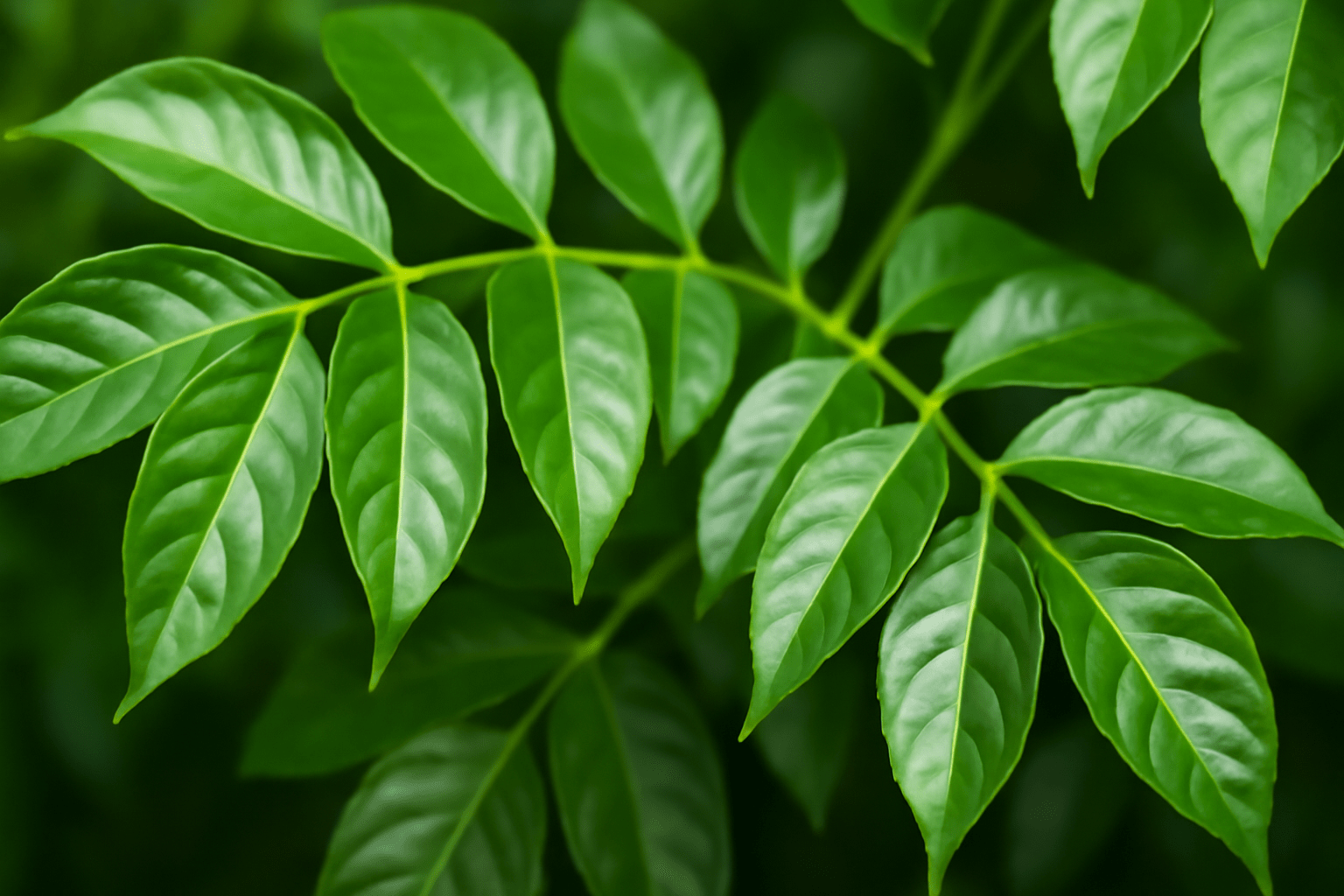
🌿 Why Should You Choose the Shamel Ash Tree? 🌿
- Environmental Benefits: The Shamel Ash tree helps improve air quality 🌬️ by filtering pollutants and providing much-needed oxygen 🌱. It’s a natural air purifier, and its shade can lower temperatures in urban areas 🏙️, reducing the heat island effect 🌡️.
- Aesthetic Appeal: The Shamel Ash brings year-round beauty 🌸. From its delicate, glossy leaves to its soft yellow fall foliage 🍁, this tree is a stunning focal point. It provides elegance and adds visual interest to your landscape at every stage of growth 🌱.
The Shamel Ash tree is a versatile, quick-growing, and environmentally beneficial tree that can quickly transform your landscape into a beautiful, shaded oasis 🌞. Whether you’re planting it for shade, privacy, or environmental benefits 🌍, the Shamel Ash is a fantastic choice for anyone looking to add a tree that offers both beauty and functionality 🌿.
So, if you’re ready to enhance your landscape with a tree that offers beauty, functionality, and easy care 🌱, the Shamel Ash tree is the perfect option 🌳. Get started on your tree-planting journey today and watch it grow into a majestic, thriving centerpiece for your garden! 💚🌳
🌳 The Benefits of the Shamel Ash Tree 🌳
The Shamel Ash tree isn’t just a pretty face—it comes with a range of benefits that can elevate any garden or landscape. Whether you’re looking for shade, an environmentally-friendly addition, or simply a low-maintenance tree, the Shamel Ash ticks all the boxes. Let’s dive into why this tree might be the perfect choice for your outdoor space. 😊
🌞 1. Aesthetic Appeal: Beauty Year-Round
🍃 Lush Foliage:
The Shamel Ash has dense, glossy leaves that stay vibrant throughout the growing season. In fall, its leaves turn a warm yellow, adding seasonal color and charm to your garden.
🌳 Graceful Shape:
With its tall, upright structure and spreading canopy, this tree has an elegant appearance that works well in both formal and natural landscapes.
🐦 Attracts Wildlife:
The flowers, leaves, and seeds of the Shamel Ash attract a variety of local wildlife, from pollinators like bees to birds that feed on the seeds.

🌍 2. Environmental Benefits: A Green Hero 🌿
🌬️ Air Quality Improvement:
Like all trees, the Shamel Ash helps improve air quality by absorbing carbon dioxide and releasing oxygen. This can contribute to a healthier, cleaner environment.
🌱 Carbon Sequestration:
By storing carbon in its leaves and roots, the Shamel Ash plays a small but significant role in reducing the overall carbon footprint.
🦜 Provides Habitat:
The Shamel Ash offers shelter for various birds and insects, supporting local biodiversity and fostering a balanced ecosystem.
💧 3. Low Maintenance and Resilient
🌵 Drought-Tolerant:
Once established, this tree requires minimal watering, making it an excellent choice for water-conscious gardeners or areas prone to drought.
🐞 Resistant to Pests and Diseases:
The Shamel Ash has a natural resistance to many pests, including the invasive Ash Borer. This makes it a great option for areas where pests are a concern.
🌿 Adaptable to Soil Types:
Whether you have sandy, clay, or loamy soil, the Shamel Ash can thrive. It’s not picky about soil type, making it an easy tree to plant in different environments.
🌳 4. Fast Growth and Shade Coverage
⏳ Quick Growth:
Unlike many trees that take years to mature, the Shamel Ash grows quickly, adding up to 3-4 feet per year. In just a few years, it can provide the shade and privacy you’ve been waiting for.
🌞 Perfect for Shading:
The broad canopy of the Shamel Ash offers fantastic shade, making it a go-to choice for hot climates and areas where you want to cool down your surroundings.
In summary, the Shamel Ash tree isn’t just a beautiful addition to your landscape—it also provides a host of environmental, aesthetic, and practical benefits. Whether you want to create a cool, shaded area, improve air quality, or plant a low-maintenance tree, the Shamel Ash is a versatile choice that delivers on all fronts. 🌿🌟
🌱 Shamel Ash Tree Care: Essential Tips 🌱
Taking care of your Shamel Ash tree is easy once you understand its needs. With the right attention, this fast-growing tree can thrive and provide years of beauty and benefits. Whether you’re a beginner or have some gardening experience, these practical care tips will help you keep your tree healthy and strong. Let’s get started! 😊🌟
🌳 1. Planting Your Shamel Ash Tree: Getting Started Right 🌳
⏰ Best Time to Plant:
The ideal times to plant your Shamel Ash are in early spring or late fall when the tree is dormant. This allows it to establish roots before the heat of summer or the cold of winter. 🌞❄️
📍 Choosing the Right Location:
Make sure to plant your tree in a spot with full sunlight, as the Shamel Ash thrives in sunny areas. It can tolerate partial shade but will grow best in bright, open spaces. 🌞🌱
🌱 Soil Requirements:
While the Shamel Ash is adaptable, it prefers well-draining soil with a slightly acidic to neutral pH. If your soil is heavy clay, consider mixing in compost or sand to improve drainage. 🌍🧑🌾
💧 2. Watering: How Much Is Enough? 💧
💦 Watering Young Trees:
Newly planted Shamel Ash trees need regular watering to establish their roots. Water deeply once a week during the first growing season, especially if it’s dry. Aim to moisten the soil down to at least 12 inches. 🌧️🌱
🌾 Watering Established Trees:
Once your tree is established, it’s fairly drought-tolerant. Watering once or twice a month should be sufficient, but always monitor soil moisture during prolonged dry spells. 🌞💧
⚠️ Signs of Over or Underwatering:
Yellowing leaves 🍂 or wilted foliage can indicate watering issues. If the soil is constantly soggy, it might be a sign of overwatering 💦, while dry, crispy leaves 🔥 suggest the tree needs more water.
🌿 3. Fertilizing: Keeping Your Tree Nourished 🌿
🌸 When to Fertilize:
Fertilize your Shamel Ash in early spring before the growing season begins 🌷. You can also give it a boost in late summer or early fall with a slow-release fertilizer to support root development. 🍂🌱
🏵️ What Type of Fertilizer to Use:
Use a balanced fertilizer (e.g., 10-10-10) that contains equal parts nitrogen, phosphorus, and potassium. Organic options, such as compost or manure, are also great for enriching the soil and promoting healthy growth. 🌻🌿
✂️ 4. Pruning and Shaping: Keep It Healthy and Attractive ✂️
🕰️ Best Time for Pruning:
The ideal time to prune your Shamel Ash is in late winter or early spring while the tree is still dormant. This helps minimize stress and promotes strong new growth. 🌸🍃
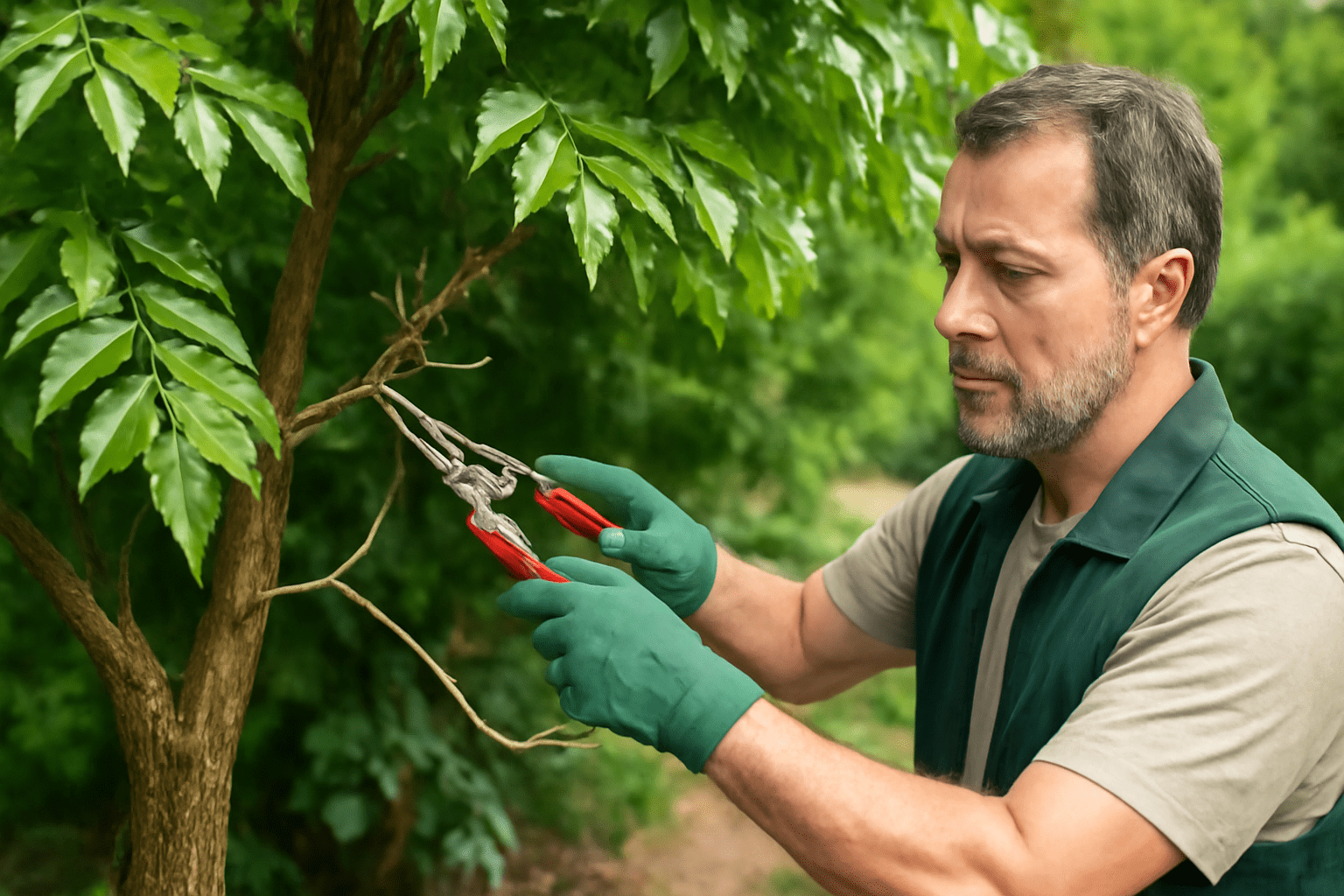
🪴 What to Prune:
Focus on removing dead or damaged branches to prevent disease 🦠. You can also shape the tree by thinning out crowded branches to improve air circulation 🍃 and sunlight penetration. 🌞🌿
✂️ How to Prune:
Use clean, sharp pruning shears ✂️ to make clean cuts. Always prune at a slight angle just above a bud or lateral branch to encourage healthy growth. 🌱🌳
🌟 5. Protecting from Pests and Diseases 🌟
🐞 Common Pests:
The Shamel Ash is generally resistant to pests 🐜 but may attract aphids, scale insects 🐛, and occasionally the ash borer 🦗. Keep an eye out for discolored or deformed leaves 🍂, which can signal pest issues.
🦋 Natural Pest Control:
To prevent infestations, encourage natural predators like ladybugs 🦋, or use organic insecticidal soap 🧴 if needed. Always check the underside of leaves for aphids or eggs 🥚.
⚠️ Diseases to Watch For:
While the Shamel Ash is quite hardy 💪, it can be prone to leaf spot 🍃, powdery mildew 🌬️, or ash yellows. Good air circulation and proper spacing between trees can help prevent fungal diseases. If you spot signs of disease, remove affected leaves or branches and dispose of them to limit spread. 🦠🚮
By following these simple care tips, your Shamel Ash tree will thrive 🌳💚 for years to come! With the right planting location, watering schedule, and maintenance, you’ll be able to enjoy its shade and beauty in your landscape. 🌳🌞💧
🌿 Landscaping Ideas with the Shamel Ash Tree 🌿
The Shamel Ash tree is a versatile and attractive addition to any landscape. Whether you’re designing a residential garden or an urban green space, this tree can serve multiple purposes, from providing shade to enhancing the aesthetic appeal of your yard. Here are some creative and practical landscaping ideas that make the most of this beautiful tree! 😊🌳

🌳 1. Create Shade and Privacy 🌳
🏖️ Shade for Patios and Outdoor Spaces:
Plant your Shamel Ash near patios, decks, or seating areas to provide much-needed shade during hot summer months. Its wide canopy creates a cool, relaxing space, making it perfect for outdoor dining or lounging. 🌞🍃
🌳 Natural Privacy Screen:
Position the tree strategically to create a natural privacy barrier between properties or block out unsightly views. Plant several Shamel Ash trees in a row to form a dense, leafy hedge that provides both privacy and a beautiful green backdrop. 🌿🏡
🌆 2. Ideal for Urban and Street Landscaping 🌆
🏙️ Perfect for City Streets:
The Shamel Ash is an excellent choice for urban landscapes due to its resilience to pollution, drought, and compact soil. Plant it along streets or sidewalks to add greenery and improve air quality in cities. 🌳🚶♀️
🌳 Street Tree for Cool Sidewalks:
This tree works wonders for urban areas with limited green space. Its fast growth provides immediate relief from heat islands, making it an ideal shade tree for sidewalks or along roads where people walk frequently. 🌇🌞
💼 Low-Maintenance for Busy Areas:
Given its ability to thrive in urban environments, the Shamel Ash is a low-maintenance tree that can withstand harsh conditions while still offering beauty and shade. 🌿🏙️
🌸 3. Add Focal Points and Visual Interest 🌸
🌟 Statement Tree in Your Yard:
Whether you’re looking to add a statement tree or a focal point, the Shamel Ash fits the bill. Its elegant shape and vibrant green leaves create a stunning visual centerpiece, especially when placed in the center of your garden or landscape design. 🌿🌳
🎨 Color Contrast in Seasonal Gardens:
In fall, the Shamel Ash’s golden-yellow leaves provide a striking contrast to evergreen plants. Plant it near colorful flowering shrubs or perennials to enhance the seasonal interest in your garden. 🍁🌸

🌻 4. Companion Planting and Garden Design 🌻
🌷 Pair with Flowering Plants:
Create a visually pleasing garden by planting flowers like lavender, daylilies, or hostas underneath your Shamel Ash. These low-growing plants complement the tree’s upright structure and thrive in the shade it provides. 🌿🌼
🌸 Use as a Backdrop for Flower Beds:
Plant your Shamel Ash behind flower beds or herb gardens to create a natural backdrop. The tree’s dense foliage will frame your garden beautifully while allowing the flowers in front to stand out. 🌸🌿
🌱 Ground Cover Ideas:
Consider planting ground covers like ferns or creeping thyme around the base of the tree. These plants thrive in the partial shade of the Shamel Ash and will create a lush, green carpet underneath its branches. 🍃🌱
🌳 5. Enhance Green Spaces with Multiple Trees 🌳
🌲 Create a Natural Woodland Feel:
Plant multiple Shamel Ash trees in your yard or garden to mimic the feel of a woodland or forest. The dense canopy of these trees will provide a shaded retreat, perfect for relaxation or enjoying nature. 🍂🌿
🚶♀️ Line Walkways or Driveways:
The Shamel Ash makes a lovely tree to line walkways or driveways. Planting these trees in a staggered row will add a sense of symmetry and beauty to your outdoor space while offering additional shade as you walk or drive by. 🚗🌳
Whether you’re looking for shade, beauty, or a privacy screen, the Shamel Ash tree can fulfill all these roles and more. By thoughtfully placing this tree in your landscape, you’ll create a vibrant, functional outdoor space that will flourish for years to come! 🌳💚
⚠️ Common Challenges and Solutions for the Shamel Ash Tree ⚠️
While the Shamel Ash tree is relatively low-maintenance and resilient, there are a few common challenges that gardeners and landscapers may encounter. Fortunately, with the right care and knowledge, these issues can be easily managed. Let’s go over some of the most frequent problems and how to solve them! 😊🌿
🍂 1. Leaf Drop and Yellowing 🍂
🌿 Problem:
If your Shamel Ash is losing its leaves too early or showing yellowing, it could be a sign of stress. This is often due to watering issues, nutrient imbalances, or environmental factors. 🍁🍂
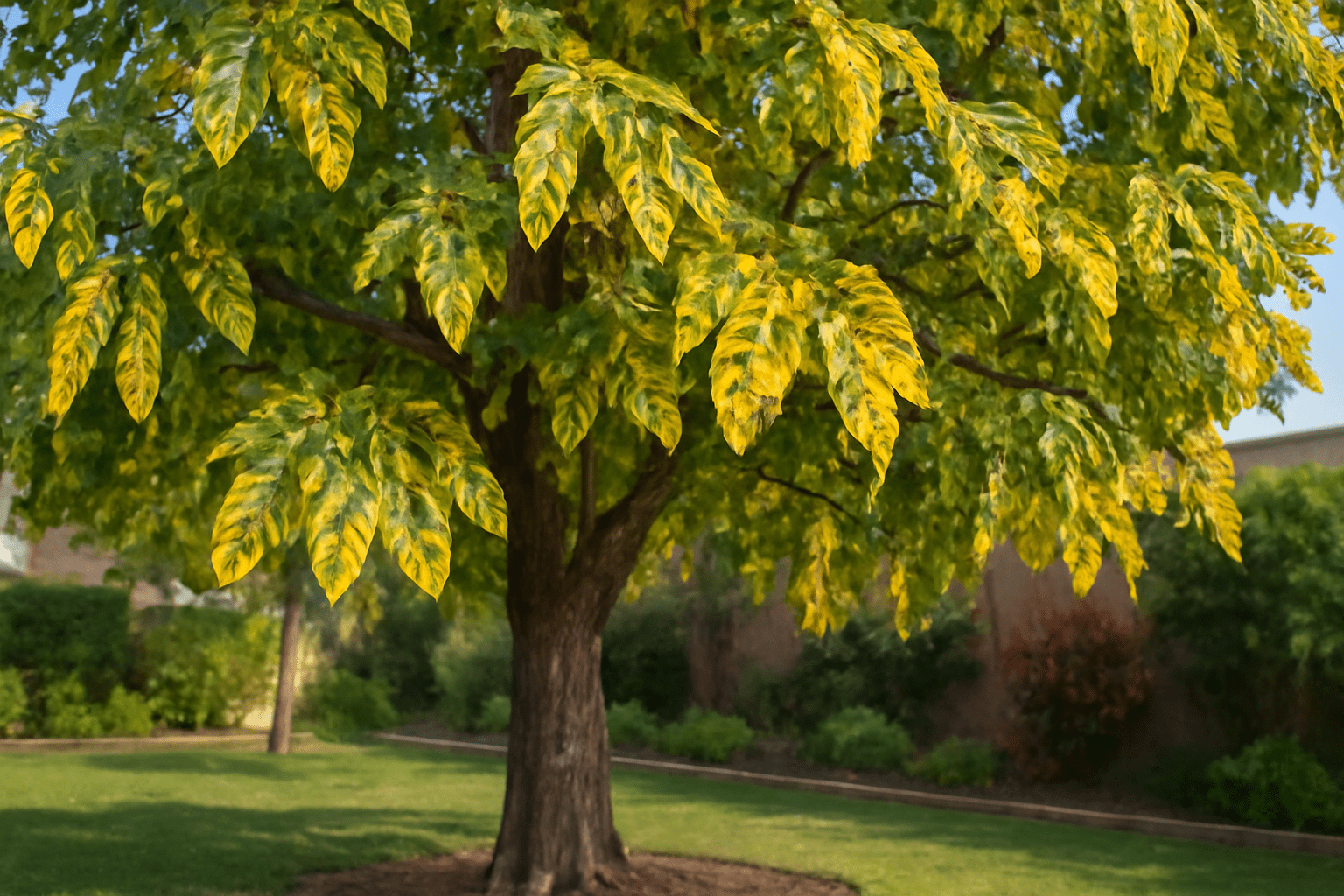
💧 Solution:
- Watering Issues: Ensure your tree is receiving the right amount of water. Overwatering can lead to root rot 💦, while underwatering causes dehydration. A good rule of thumb is to water deeply but infrequently, especially once the tree is established. 🌱
- Nutrient Deficiency: If yellowing persists, check if your tree is lacking essential nutrients, particularly nitrogen 🌾. Consider adding a slow-release fertilizer in early spring to boost its health. 🌸
- Natural Fall Process: If the yellowing happens in fall 🍂, it’s completely normal as the tree prepares for winter ❄️. Don’t worry about it unless the problem occurs during the growing season.
🌡️ 2. Tree Stress in Urban Environments 🌡️
🏙️ Problem:
Urban conditions, such as compacted soil, pollution, or limited root space, can stress the Shamel Ash, affecting its growth and overall health. 🏢🌳
🌱 Solution:
- Soil Improvement: For urban planting, amend the soil around the tree with organic matter 🌿 to improve its structure and drainage. This allows the roots to spread more easily and access nutrients. 💧
- Mulching: Apply a layer of mulch around the base of the tree 🌾 to retain moisture and keep the soil temperature consistent. Be sure to keep mulch away from the trunk to prevent rot 🛑.
- Protecting Roots: If planting near hard surfaces like sidewalks 🚶♂️, install root barriers or give the tree ample space to prevent root damage. 🌳
🐞 3. Pest Infestations (Aphids, Scale, and Ash Borers) 🐞
🐜 Problem:
While the Shamel Ash is resistant to many pests, it can still attract aphids, scale insects, and the invasive ash borer. These pests can cause leaf damage 🍂, stunted growth, and weaken the tree over time. 🐛🦠
💪 Solution:
- Aphids & Scale: Inspect the underside of leaves regularly for small, green aphids or round, sticky scale insects 🐞. If you spot an infestation, gently spray the affected areas with organic insecticidal soap 🧴 or use a strong stream of water to wash them off. 🌿💧
- Ash Borers: If you notice signs of ash borer infestation (e.g., dying branches, tunnels in the bark) ⚠️, it’s essential to act quickly. Prune off affected branches ✂️ and dispose of them, and consider using insecticides specifically targeting these pests. If the infestation is severe, seek professional help. 🚑
🍂 4. Powdery Mildew and Leaf Spot 🍂
🌬️ Problem:
The Shamel Ash can sometimes develop fungal diseases like powdery mildew and leaf spot, which cause white, powdery patches on leaves and dark spots, respectively. 🍃
🍄 Solution:
- Pruning: Remove any infected leaves 🍂 or branches to prevent the spread of disease. Dispose of the leaves away from the tree to avoid reinfection. 🧹
- Improving Air Circulation: Ensure the tree has enough space around it for air to circulate freely 🌬️. This reduces humidity around the leaves and helps prevent fungal growth. 🌿
- Fungicide: If the problem persists, consider using an organic fungicide or copper-based treatment in early spring 🌸 before the disease becomes widespread.
🌿 5. Weak or Unstable Branches 🌿
🌬️ Problem:
Sometimes, the Shamel Ash can develop weak or poorly-formed branches, especially if not pruned regularly. These branches can be more susceptible to breakage during storms or heavy winds 🌪️.
✂️ Solution:
- Pruning for Strength: Prune any dead or weak branches ✂️ to encourage stronger, healthier growth. Focus on removing branches that cross each other or grow inward to ensure the tree has a well-structured canopy. 🌳
- Proper Watering and Fertilization: Weak growth can also be a sign of improper watering or nutrient deficiencies 🌱. Ensure your tree is receiving the right balance of nutrients and moisture to promote strong, resilient branches. 💪
By addressing these common challenges, you can keep your Shamel Ash tree healthy and thriving 🌳💚. With a little attention and care, you’ll enjoy its beauty and benefits for years to come! 🌿🌟
🌿 Final Thoughts 🌿
The Shamel Ash tree is a fantastic choice for anyone looking to enhance their landscape with a low-maintenance, fast-growing, and visually appealing tree. Whether you’re aiming to create shade, add privacy, or simply enjoy its striking foliage, this tree delivers on all fronts. 🌳💚
By following the care tips and landscaping ideas provided, you’ll be well on your way to cultivating a healthy, thriving tree that will offer years of beauty and environmental benefits. Remember, the Shamel Ash isn’t just a tree—it’s an investment in a greener, more vibrant space that can enhance your garden or urban landscape. 🌿🌱
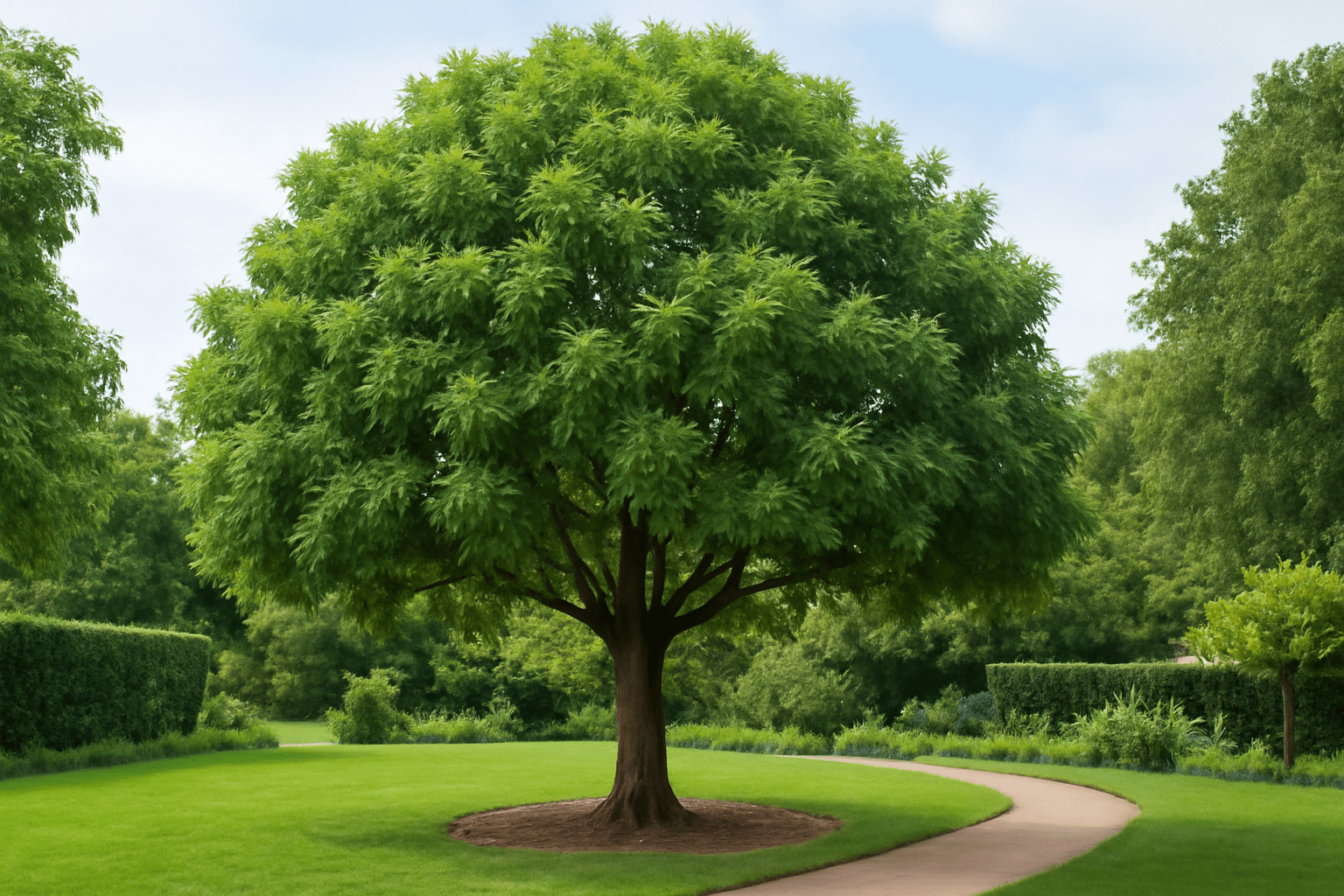
So, whether you’re a gardening newbie or an experienced landscaper, take the plunge and add a Shamel Ash tree to your property. With just a little attention, you’ll soon enjoy all the wonderful benefits it has to offer! 😊🌿
Happy planting! 🌳🌟
Frequently Asked Questions (FAQs)
How fast does the Shamel Ash tree grow?
The Shamel Ash tree is a fast-growing species, typically adding 3-4 feet of height per year. This makes it an ideal choice if you want quick shade or privacy in your landscape.
Can the Shamel Ash tree tolerate cold weather?
The Shamel Ash is best suited for warmer climates. It can handle mild winters but may struggle in areas with harsh, freezing temperatures. It thrives in USDA Hardiness Zones 8-10.
How do I care for my Shamel Ash tree during the summer?
During the summer, make sure your Shamel Ash is watered deeply but not too frequently. As it’s drought-tolerant once established, watering once or twice a month is usually enough. Additionally, apply mulch around the base to help retain moisture and regulate soil temperature.
What type of soil does the Shamel Ash tree need?
The Shamel Ash is adaptable to a wide range of soil types, but it prefers well-draining soil with a slightly acidic to neutral pH. It can tolerate sandy or clay soils, making it a versatile choice for different landscapes.
Can I plant a Shamel Ash tree in a container?
Yes, you can plant a Shamel Ash in a large container, especially when it’s young. However, keep in mind that as the tree matures, its roots will need more space. Consider transplanting it into the ground once it outgrows the pot.
Does the Shamel Ash tree need full sun?
Yes, the Shamel Ash prefers full sunlight for at least 6 hours a day to grow optimally. While it can tolerate partial shade, it will grow slower and may not produce as much foliage.
How can I prevent pests from damaging my Shamel Ash tree?
Regularly inspect your Shamel Ash for pests like aphids, scale insects, and ash borers. Use organic insecticidal soap or neem oil to manage minor infestations, and prune any affected branches to prevent further spread.
Why are the leaves of my Shamel Ash tree turning yellow?
Yellowing leaves on your Shamel Ash may be a sign of watering issues, nutrient deficiencies, or stress from extreme temperatures. Ensure proper watering habits and consider fertilizing with a balanced fertilizer to correct nutrient imbalances.
